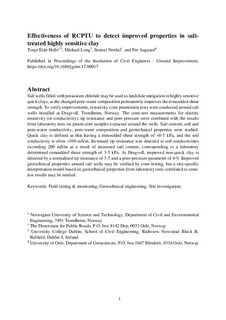| dc.contributor.author | Helle, Tonje Eide | |
| dc.contributor.author | Long, Michael | |
| dc.contributor.author | Nordal, Steinar | |
| dc.contributor.author | Aagaard, Per | |
| dc.date.accessioned | 2017-10-26T11:33:47Z | |
| dc.date.available | 2017-10-26T11:33:47Z | |
| dc.date.created | 2017-07-06T10:04:12Z | |
| dc.date.issued | 2017 | |
| dc.identifier.issn | 1755-0750 | |
| dc.identifier.uri | http://hdl.handle.net/11250/2462362 | |
| dc.description.abstract | Salt wells filled with potassium chloride may be used as landslide mitigation in highly sensitive quick clays, as the changed pore-water composition permanently improves the remoulded shear strength. To verify improvements, resistivity cone penetration tests were conducted around salt wells installed at Dragvoll, Trondheim, Norway. The cone-test measurements for electric resistivity (or conductivity), tip resistance and pore pressure were combined with the results from laboratory tests on piston-core samples extracted around the wells. Salt content, soil and pore-water conductivity, pore-water composition and geotechnical properties were studied. Quick clay is defined as that having a remoulded shear strength of <0·5 kPa, and the soil conductivity is often <100 mS/m. Increased tip resistance was detected at soil conductivities exceeding 200 mS/m as a result of increased salt content, corresponding to a laboratory-determined remoulded shear strength of 3·5 kPa. At Dragvoll, improved non-quick clay is detected by a normalised tip resistance of 3·5 and a pore-pressure parameter of 0·9. Improved geotechnical properties around salt wells may be verified by cone testing, but a site-specific interpretation model based on geotechnical properties from laboratory tests correlated to cone-test results may be needed. | nb_NO |
| dc.language.iso | eng | nb_NO |
| dc.publisher | Thomas Telford (ICE Publishing) | nb_NO |
| dc.title | Effectiveness of resistivity cone penetration tests in salt-treated highly sensitive clay | nb_NO |
| dc.type | Journal article | nb_NO |
| dc.description.version | acceptedVersion | nb_NO |
| dc.source.journal | Proceedings of the Institution of Civil Engineers - Ground Improvement | nb_NO |
| dc.identifier.doi | https://doi.org/10.1680/jgrim.17.00017 | |
| dc.identifier.cristin | 1481162 | |
| dc.description.localcode | This is the authors' accepted and refereed manuscript to the article. Locked until August 11, 2018 due to copyright restrictions. The final publication is available at http://www.icevirtuallibrary.com/doi/10.1680/jgrim.17.00017 | nb_NO |
| cristin.unitcode | 194,64,35,0 | |
| cristin.unitname | Institutt for bygg, anlegg og transport | |
| cristin.ispublished | true | |
| cristin.fulltext | postprint | |
